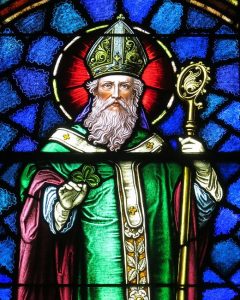 ‘Tis a grand time of year when you’re Irish. Or when you’re of Irish heritage, or simply wish you were. Perhaps you claim you’re Irish even though you’re not. St. Patrick’s Day, which is today, draws out the Irish in plenty of people all over the world.
‘Tis a grand time of year when you’re Irish. Or when you’re of Irish heritage, or simply wish you were. Perhaps you claim you’re Irish even though you’re not. St. Patrick’s Day, which is today, draws out the Irish in plenty of people all over the world.
But who was St. Patrick and why do people everywhere celebrate this day as an international holiday?
St. Patrick was a fifth-century Romano-British Christian missionary and bishop in Ireland. Known as the “Apostle of Ireland”, he is the primary patron saint of Ireland. He is credited with bringing Christianity to Ireland.
Irish Music For St. Patrick’s Day
In his book, A History of Irish Music, William Grattan Flood writes, “No enemy speaks slightingly of Irish music, and no friend needs fear to boast of it.” So what is the story behind Irish music?
Today I am going to talk about four different types of Irish music.
1. Traditional Irish Music
Musicians sang early Irish songs a capella. They introduced pipes, fiddles, and bodhrans (Irish drums) later. These instruments have become a staple of what we now know to be “traditional” Irish music. However, other instruments like the accordion, flute, and guitar have also become popular. Groups like Altan, The Chieftains and Celtic Woman provide traditional Irish tunes. They sing some of the most popular session songs. For example “Danny Boy,” “An Irish Lullaby,” “Rocky Road to Dublin,” “Irish Eyes are Smiling,” and “Finnegan’s Wake.”
2. Modern Irish Music
Who said that Irish music could only be old, sad and nostalgic? Many famous music groups from Ireland have blessed us with their sound, including U2, Sinead O’Connor, The Cranberries and Van Morrison.
3. Irish Harp Music
Francis Bacon once said that “no harp hath the sound so melting as the Irish harp.” Irish harp music dates back to the 10th-century Irish court when the harp was strung with wires of brass and plucked with long fingernails. It was the centerpiece of royal Irish music until it was eliminated by the British, surviving only as the dance music of the poor. Irish harp music, therefore, is considered the ancestor of Irish traditional music.
One of the biggest contributors to this form of Irish music was the blind harpist Turlough O’Carolan. The wandering harper lived from 1670-1738 and composed hundreds of tunes.
4. Celtic Music
Is there a difference between Celtic music and Irish music? Yes and no. Celtic (pronounced “kel-tic”) originally referred to a group of people who settled in Ireland, Scotland, Britain and surrounding areas. Celtic music in this sense is not specifically Irish. Nevertheless, it is considered easy-listening, mood music that has an enchanting and relaxing feel.
Therefore, Irish music can be Celtic, but Celtic music isn’t always Irish. Some consider Enya to be modern Celtic music with a haunting Irish sound. Here is one of my favorites.

Top o’ the mornin’ to ya, Brad!
And the rest of the day to you
Enjoying the music here in Phoenix. Happy St. Pet’s, Brad.
Your music selections for today were so beautiful. Happy St. Pat’s to you and Linda.
Wonderful. Thanks, Brad.
Thank you, Brad! Beautiful selections!!
Wishing you and Linda a Happy St Patrick’s Day. We celebrated with corned beef and cabbage.
Pingback: The Claypool Lennon Delirium - Brad's Music Room